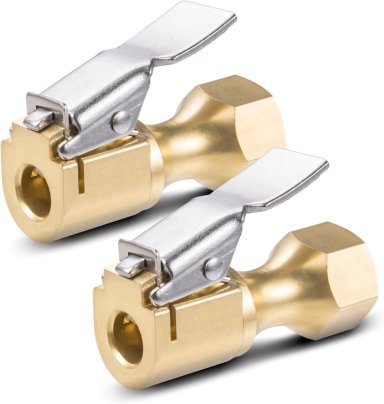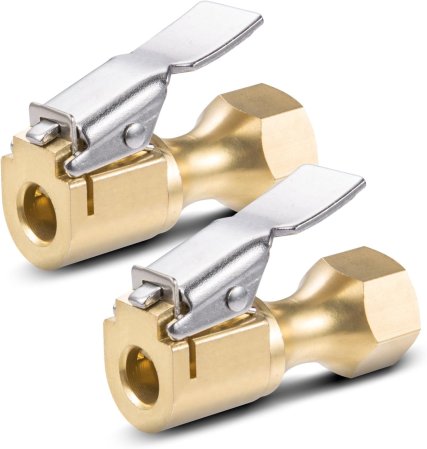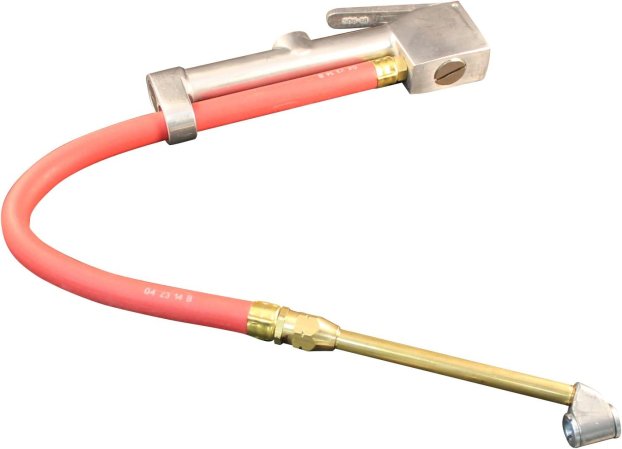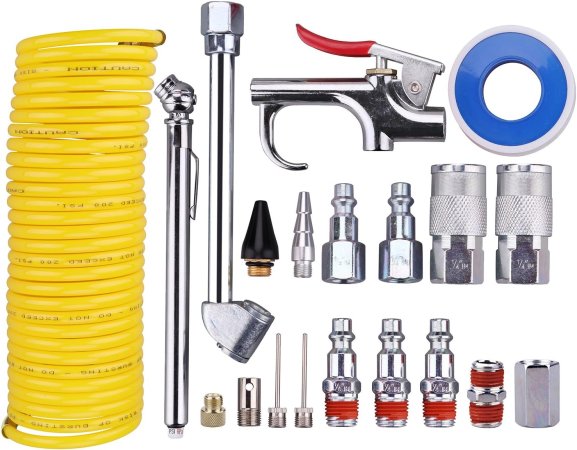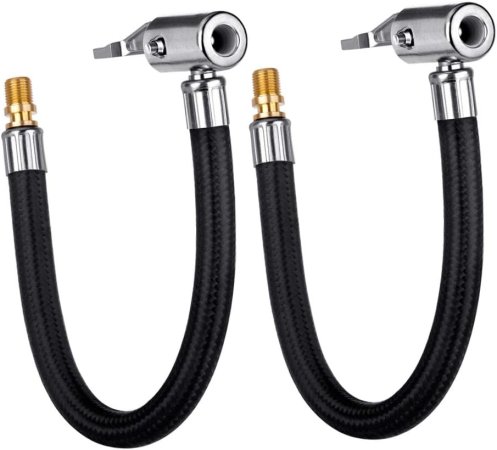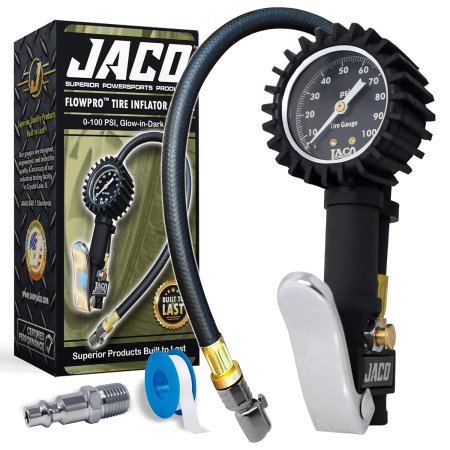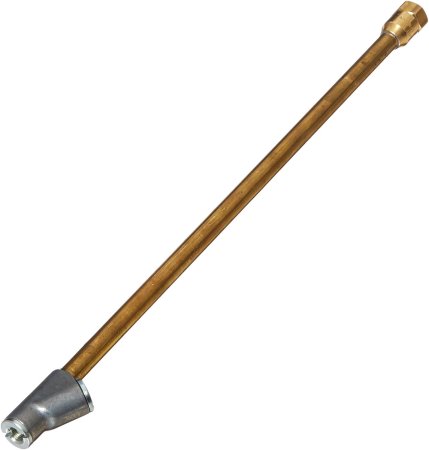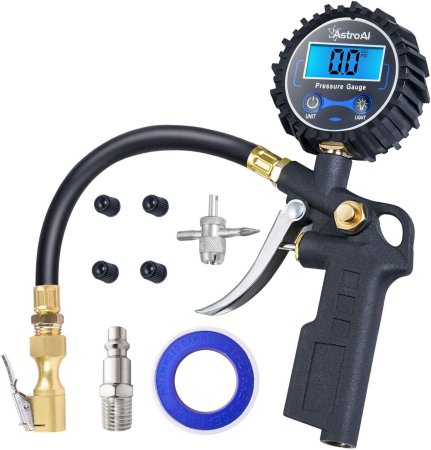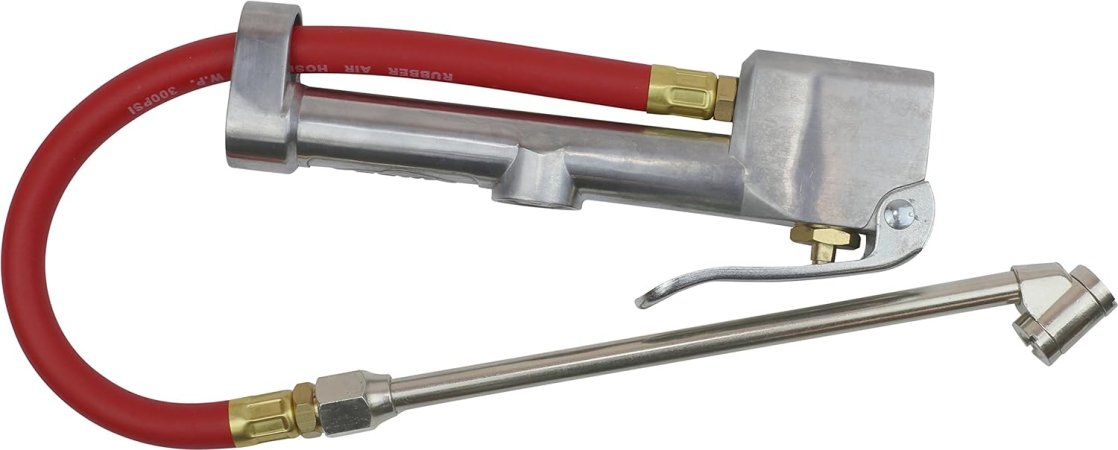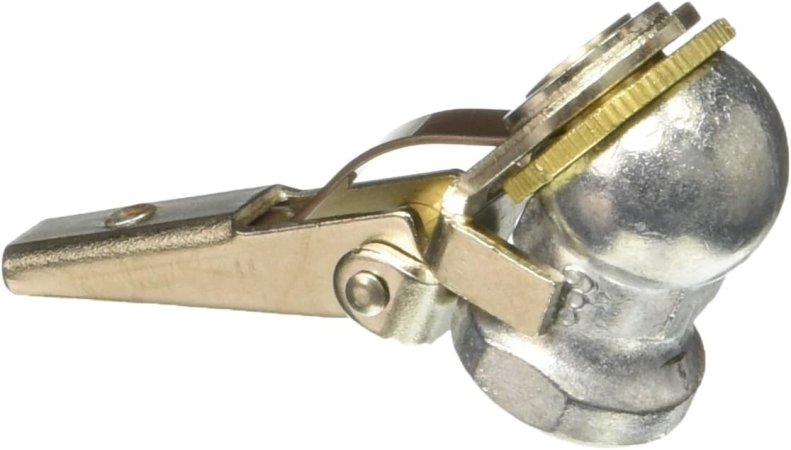We may earn revenue from the products available on this page and participate in affiliate programs. Learn more ›
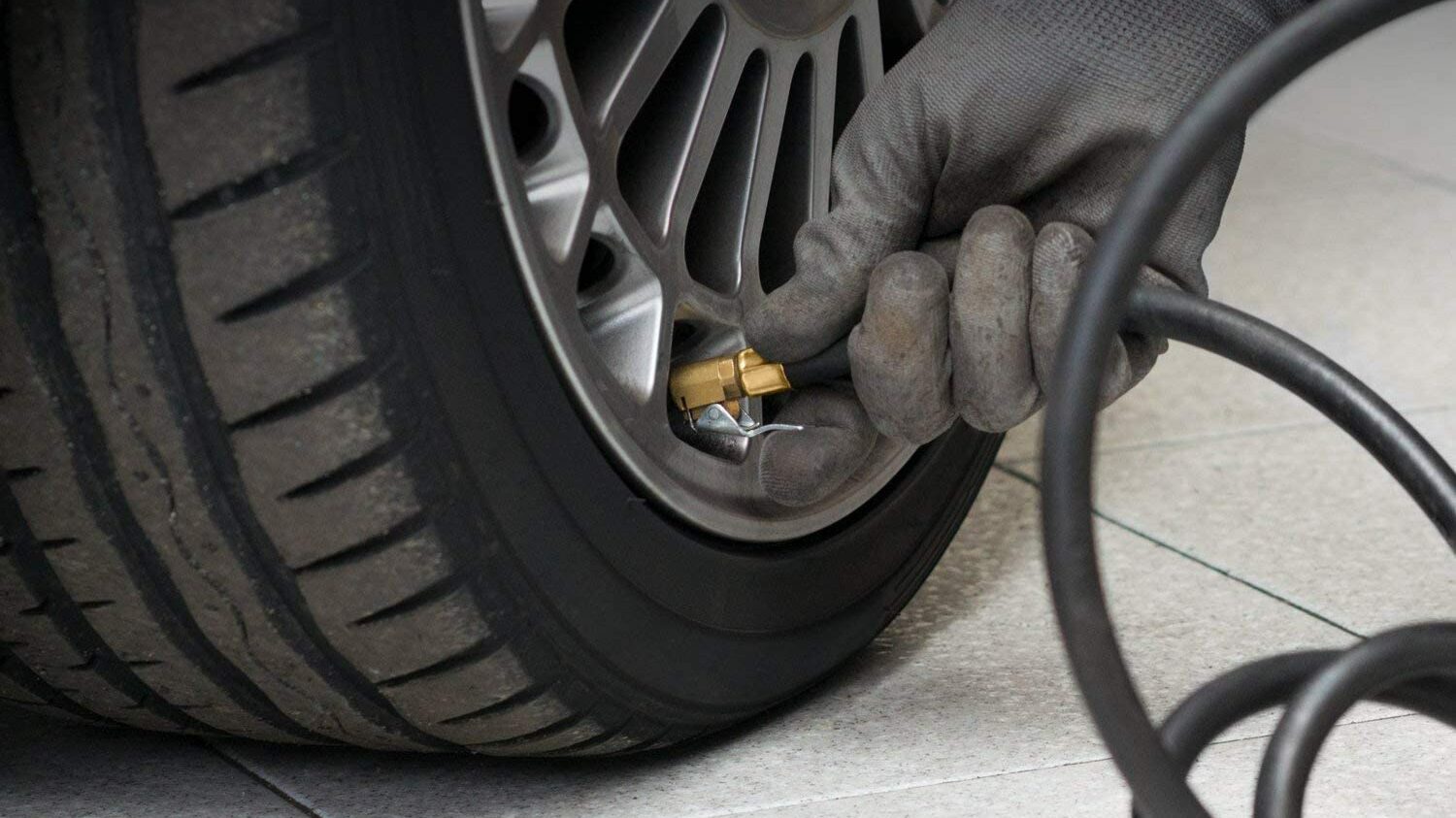
It is really easy for the big things to take up all of your attention when setting up your tool collection. While you certainly benefit from an extensive collection of hand and power tools, it’s the little things that’ll throw a wrench in the spokes. Air chucks are a perfect example of a specialty tool everyone should keep on hand. You can’t fill a tire with wrenches and hammers. As cool as that would be, you’re better off getting one of your own to keep around the shop.
And sure, you can borrow one from your buddy, but you run the risk of damaging the relationship when that thing slips into the abysmal crack that sucks up 10mm sockets. Air chucks are pretty simple, and you can probably find the exact one you need in just a few minutes. That doesn’t mean there isn’t additional information worth knowing, though. We’re here to shed a little bit of light on the matter so that you walk away with the air chuck you need.
Types of Air Chucks
Closed Flow
Most air chucks use a closed-flow design. This type keeps air from flowing until it is pressed or locked onto the valve stem. These are generally the best choice for an air compressor that features a tank as the compressor doesn’t have to work to keep the tank filled as you work.
Open Flow
Open flow chucks allow air to continuously flow through once they are attached to an air line and are ideal for use with a tankless compressor. This type of air chuck is growing in popularity as it’s often viewed as the most efficient type. Many are designed for use with Tire Pressure Gauges.
Clip-On vs. Push-on vs. Screw-On
Air chucks secure to the valve stem in a few ways. Clip-on and push-on are the most common designs used. As the name implies, a push on air chuck requires you to push it down on the valve stem to begin supplying air. Clip-on models work similarly but feature a clipping mechanism to keep it in place, reducing the risk of letting air leak out. A third type screws onto the valve stem. Screwing into place creates a superior seal but is considered more trouble than it’s worth, considering clip-on chucks are very reliable.
Summary List
- Best Overall: AstroAI Heavy Duty Closed Flow Lock On Air Chuck
- Best Value: Milton S-693 1/4-Inch Straight Foot Dual Head Air Chuck
- Premium Pick: Milton (S-506) Original Dual Head Chuck Tire Inflator
- Best Starter Set: WYNNsky Air Compressor Kit
Also Consider
- Lumiteco 2-Piece Locking Air Chuck With Hose
- Jaco FlowPro Tire Inflator With Pressure Gauge
- Milton S-693-12 1/4-Inch FNPT Extended Reach Dual Head Air Chuck
- AstroAI Digital Tire Inflator with Pressure Gauge
- EPAuto Commercial Grade Dual Head Tire Inflator Gauge with Air Hose
- Milton S-698 1/4-Inch FNPT Single Head Air Chuck With Grip
Best Air Chucks Reviews & Recommendations
Best Overall
AstroAI Heavy Duty Closed Flow Lock On Air Chuck
Best Value
Milton S-693 1/4-Inch Straight Foot Dual Head Air Chuck
Premium Pick
Milton (S-506) Original Dual Head Chuck Tire Inflator
Best Starter Set
WYNNsky Air Compressor Kit
Honorable Mention
Lumiteco 2-Piece Locking Air Chuck With Hose
Honorable Mention
Jaco FlowPro Tire Inflator With Pressure Gauge
Honorable Mention
Milton S-693-12 1/4-Inch FNPT Extended Reach Dual Head Air Chuck
Honorable Mention
AstroAI Digital Tire Inflator with Pressure Gauge
Honorable Mention
EPAuto Commercial Grade Dual Head Tire Inflator Gauge with Air Hose
Honorable Mention
Milton S-698 1/4-Inch FNPT Single Head Air Chuck With Grip
Our Verdict on the Best Air Chucks
Our top pick goes to the AstroAI Heavy Duty Closed Flow Lock-On Air Chuck because it’s an affordable option that offers respectable quality for a low cost. Speaking of cost, the price is actually for two chucks, meaning you don’t need to double down for a backup. But if saving money is the primary concern, you can grab the Milton S-693 1/4-Inch Straight Foot Dual Head Air Chuck, which comes from an industry leader.
Our word isn’t gospel, though. Feel free to leave a comment and let us know what you think the best air chuck is!
Benefits of Air Chucks
- Inflate tires. An air chuck’s sole purpose is to inflate tires. They fit over the valve stem and go to work. While that is a simple job, it’s essential because a tire without air is nothing more than a hunk of rubber.
- Adjust air pressure. Basic maintenance and performance driving of any kind requires you to monitor and adjust air pressure in your tires. Air chucks are essential to the process. If you need to make these adjustments while away from the shop, you should consider our guides to portable air compressors, small air compressors, portable tire inflators, and RV air compressors.
- Tackle miscellaneous tasks. Some air chucks come as part of a kit that allows you to do more than inflate tires. You can use them for filling up tires, sports equipment, and even cleaning up around the shop. If you’re just starting to build a collection, you certainly should consider these kits.
Top Brands
Milton
Milton has been hard at work since 1943. In the beginning, it offered only a handful of products and focused more on quality than quantity. Today, it works out of Chicago, Ill., and has grown to become an industry leader in pneumatic accessories. The quality and praise make it hard to talk chucks without highlighting the Milton (S-506) Original Dual Head Chuck Tire Inflator.
AstroAI
AstroAI is a relatively new company that set up shop in 2016. With a headquarters in Chongqing, China, the brand aims to provide a wide range of quality products at affordable prices. It is a specialty automotive tool prevalent for performing a range of odd jobs in home garages. The AstroAI Digital Tire Inflator with Pressure Gauge’s staggering number of positive reviews make it hard to ignore.
Epauto
Another famous brand among internet consumers is EPauto. It works out of Walnut, Calif., and produces a wide range of automotive tools and parts at affordable prices. The EPAuto Commercial Grade Dual Head Tire Inflator Gauge with Air Hose is a prime example of what the brand offers.
Jaco
Since 1983, JACO has been hard at supplying the market with innovative tools to keep vehicles motoring along. The headquarters is in Franklin, Mass., and tire inflation tools are a significant focus. That said, we’re glad to have a product like the Jaco FlowPro Tire Inflator with Pressure Gauge on our list.
WYNNsky
WYNNsky’s sole focus is promoting e-commerce business while supplying quality components to the consumer. It came to the scene with plenty of experience on account of the parent company with success with air fittings. The WYNNsky Tire Inflator’s quality with Tire Pressure Gauge just goes to show why we try to tip our hats to the brand.
Air Chuck Pricing
- Under $20: single air chucks and low dollar kits are commonly found within this price range. Even air chucks from premier manufacturers list at very affordable asking prices.
- $20-40: This price range I primarily comprised of kits that include air chucks, tire pressure gauges, or a combination of other pneumatic attachments.
- $40 and up: Air chucks that go for more than $40 are your premium options. They come with features such as a flexible valve extender, a built-in pressure gauge and are offered by industry-leading suppliers.
Key Features
PSI Range
Like any air fitting, air chucks have a set pressure range that they can safely work with. If you’re working in typical settings with a basic air compressor, you likely don’t have to worry too much about this detail as most are perfectly viable. Still, it is wise to ensure the air compressor’s pressure doesn’t exceed the chuck’s limits to prevent hazardous situations. Also, be considerate of the low end of the range. If you’re working with a long hose that has a wide diameter, you need to make sure it’s supplying enough pressure for the chuck to fill the tire.
Valve Extender
An air chuck can come equipped with a built-in valve extender that provides additional reach. These extenders can vary in length and be rigid or flexible. That said, it’s worth determining if this feature is necessary for the applications you’re working with and what configuration will best complement the work. Flexible extenders are generally very desirable, but they can drive up the price point quite a bit.
Other Considerations
- Chuck Design and Build. As we know, air chucks can fasten to a valve stem in several ways, and you’ll want to consider how it does. Another design to be mindful of is the angle of the chuck. Some applications will benefit from a straight-on design, while others require the chuck to sit at an angle. Of course, build quality should also be a concern as cheap components are bound to cause more frustration than production.
- Carry Case Included. Some kits come with a carrying case, and that’s certainly worth investing in. You will have a place in the tool box for these tools, but they’re easy to lose during transportation or if you just keep them on the bench during a project. Indeed, you can purchase a pouch or case after the fact, but having one out of the gate is always a good deal.
- Hose Size. If an air chuck has a built-in hose, the length of the hose is something to pay attention to. You want to make sure it’s long enough to reach into the areas you need it to. If you’re working with a single tire application, you likely don’t need much length, but dual-wheel setups can certainly benefit for longer-than-normal hose lengths.
Tips
- You’re bound to lose, misplace, or lend out air chucks. It’s worth investing in a few to prevent yourself from winding up in a bind.
- Air chucks are relatively inexpensive, but losing them can still be extremely frustrating. It’s worth investing in a small case or pouch to help you keep track of them.
- You always want a tire to be filled to the appropriate specifications to prevent excess wear, promote performance, and reduce the likelihood of blowouts. Therefore, you’ll want a high-quality tire pressure gauge on hand, if not built right into the chuck.
- Remember, there’s a reason a tire went flat. It’s best to keep tire or inner tube repair equipment on hand so that you can deal with any punctures.
FAQs
Some air chucks attach to hoses with the use of air couplers. Many options come with these attachments and must be installed. Others use a barb connection that you must slide a hose over then secure into place with the use of a hose clamp.
Air hose diameter and length contribute to the amount of air it can flow and how much is lost. You want to consider the operating PSI range of a chuck and how much air pressure is supplied by the hose you are using to ensure it will work.
Simply put, a flat tire won’t hold any air. A dead giveaway is when the sidewall below the wheel is hardly separating it from the ground. A tire that’s low on air will still elevate the wheel, but less than it would when it’s at the proper PSI rating.
Filling tires isn’t particularly demanding of an air compressor, meaning you don’t need something large. Anything that can supply at least 1-2CFM at 90PSI is perfectly fine. If filling tires is your only concern, you can even rely on a small portable tire inflator.
